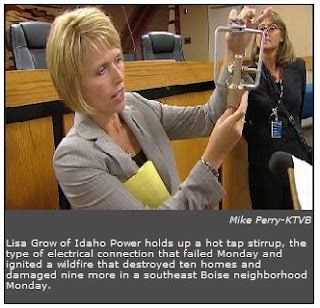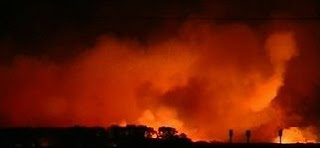 Cause of fatal Boise fire revealed
Cause of fatal Boise fire revealedThe cause of Monday's fire in Boise that burned ten homes, and may have caused the death of one resident, has been determined.
Boise Fire investigators said Thursday that an electrical connection on a powerpole, called a hot tap stirrup, arched causing molten metal to fall to the dry grass below, igniting a wildfire that took only minutes to burn ten homes and damage nine others in a southeast Boise neighborhood Monday.From KTVB.com
Lisa Grow, vice president of delivery operations and engineering for Idaho Power, said during the storm that blew through Boise Monday evening, just before 7 p.m. a tree branch fell into a powerline along Boise Avenue about five miles from the fire scene. That caused a break in the power distribution, forcing a stronger current to the hot tap stirrup miles away.
She says the 50 mph winds, plus the extra current, caused the arch that ignited the fire in the Oregon Trail Heights subdivision. The last time the connection was inspected was in 2006. According to Idaho Power, they are inspected every three years.
Update: air tanker pilot's injuries minor
Yesterday we covered the crash of the single engine air tanker (SEAT) in northwest Colorado. Thankfully, we can now report that the injuries to the pilot were minor. The SEAT went down at 3 p.m. Wednesday about 20 miles northwest of Meeker, CO. The pilot's name has not been released. The BLM says he walked away from the crash while working on a fire on BLM land and was taken by helicopter to a hospital in Grand Junction.
Ammo depot in Ukraine burns in forest fire
KIEV, August 28--Artillery shells and other ammunition at a storage site in Ukraine exploded after a forest fire spread to the facility, prompting an evacuation, emergency officials say.

The prime minister was quoted as saying nobody was seriously injured.
The Defense Ministry said the fire broke out in a forest near the town of Lozovaya, some 500 kms (300 miles) east of the capital Kiev.
Firefighters couldn't handle the blaze, and it spread to the arsenal, which contains some 100 tons of ammunition on a 1,235-acre (500-hectare) site, it said.
Prime Minister Yulia Tymoshenko said that there were no casualties, adding that 1,400 people had been evacuated and a total of 6,000 would be evacuated from the area around the facility.
About 1,400 people had been evacuated and 6,000 would be evacuated from the area around the facility, officials said.
Lidya, a local resident, said: "They told us on radio and TV we should take documents and personal belongings and leave our houses to wait near bus stops."
"People waited and waited but no transportation was provided. So people started to run, all, including disabled people and old people. I was standing here and saw everything - it was scary, I've never seen anything like that."
Nikolai Tityursky, a spokesman for the Ukrainian armed forces, said: "We have conducted a helicopter reconnaissance flight to detect the locations where the burning process is still under way, where there are still rounds of ammunition that can detonate."
"After the explosions finish, we'll send five tanks to help put out the blaze."
Ukrainian defense officials have warned that dozens of large ammunition depots inherited from the former Soviet Union are poorly maintained and represent a serious public hazard.
A fire and explosions at a munitions depot in southern Ukraine in 2004 killed five people. It took days to put the blaze out.
From Alalam.ir
UPDATE:
Some of the materials in the middle of the fire are 94,000 tons of missiles, 60 tons of propellant explosive, and Luna-M tactical missiles.
HERE is a link to a page that has two different videos of the ammo dump burning and exploding.
from the Earth Times:
The nighttime blaze near the town Lozova in Ukraine's Kharkiv province had produced hundreds of detonations so far, threatening firefighters with shrapnel and making quick control of the fire impossible, Ukrainian Prime Minister Yulia Tymoshenko said.
Two storage buildings the Soviet-era artillery shell and rocket dump were burning, and 120-millimetre mortar rounds were detonating "almost every minute" said Viktor Baloga, a government spokesman.
Emergency workers evacuated more than 6,500 residents of Lozova and surrounding villages five kilometres or less from the fire's epicentre.
One military service member was injured as a result of the fire. Windows were broken throughout Lozova and houses damaged as far as three kilometres from the fire, an army spokesman said.
A massive government effort to bring the blaze under control was in progress. Some 200 vehicles and 1,000 firefighting personnel drawn from both the military and civilian sectors were participating, said Volodymyr Shandra, Ukraine Emergency Situations Minister.
USFS diverts funds to cover fire expenses
There are a number of local stories around the nation about the U. S. Forest Service ordering Forests to take money that was planned for other uses to cover massive firefighting expenses. Here is a brief excerpt from one of the stories, this one about the Cleveland National Forest in southern California from the Union-Tribune.
Campground bathrooms and roads in the Cleveland National Forest will suffer because the U.S. Forest Service is cutting at least $400 million in programs nationwide so it has enough money to fight fires in September.If you can't get enough of this fiscal stuff, here are more articles about this in other parts of the country: Montana, Oregon, Wyoming & South Dakota, West Virginia, and Colorado.
“It's all those types of things that users typically see,” said Brian Harris, a spokesman for the agency in Rancho Bernardo.
National forests in California are on the hook to lose $33 million, and they could give up more if the Forest Service has to battle a massive wildfire. That money would have been used for removal of hazardous trees, roof repairs, new vehicles and other needs.
In the 438,000-acre Cleveland National Forest, the funding hit is estimated at $1.3 million – or roughly 5 percent of the forest's annual budget. The forest, which stretches across San Diego, Riverside and Orange counties, is a major recreation area that gets about 850,000 visits a year.
Gunbarrel fire, west of Cody, Wyoming
From the Powell Tribune
“The winds are just howling,” Clint Dawson said Wednesday, describing the wind’s rate around the Gunbarrel Fire.Goats gobble grass--and brush
Dawson is the zone fire manager for Shoshone National Forest.
In the valley — in the vicinity of the newly-relocated Gunbarrel Fire camp at Buffalo Bill State Park — the wind was gusting to 40-60 mph in the early afternoon on Wednesday. The new incident command camp is just above the reservoir west of Cody.
An aircraft flying over the fire Wednesday reported winds reaching 115 mph at 11,000 feet, Dawson said. (some of the peaks in the fire area are at about 10,000 feet-bg)
The fire was was spotting on the east side of 12,000-foot high Trout Peak, according to an incident report.
Wind often is the rule rather than the exception in the hills and mountains above the reservoir, but Dawson described these fierce winds as “abnormal.”
A red-flag warning was issued for the fire area again on Wednesday. That means low humidity and windy conditions likely will translate to potential fire growth and extreme fire behavior, said Mark Giacoletto, Shoshone Forest fire management officer.
As of Wednesday morning, the Gunbarrel Fire was roughly 10-12 miles west of Cody and north of U.S. 14-16-20. It had grown by 3,424 acres since Monday to a total of 57,384 acres and extended about 24 miles roughly from east to west. Lightning ignited the fire about 38 miles west of Cody on July 26.
At-risk structures on both ends of the fire were being closely monitored and defended by firefighters on the scene.
The price of managing and fighting the fire also is mounting. On Monday, the cost was an even $6.6 million. By Wednesday morning — before Wednesday’s fierce winds — the price tag had grown to a little over $7.6 million.
Members of the Great Basin Type 1 Incident Management Team arrived Tuesday. Official transfer of command occurred Wednesday morning.
In the 1980's we conducted some experiments using goats for fuel management on the Cleveland National Forest east of Pine Valley, California. They did a fine job of eating all of the grass and almost every leaf on every plant in a brush field. If they were brought back months later, or the following year (or two) the brush would eventually die. This was less risky than prescribed fire in an urban interface area. There were no bulldozers chewing up the ground, and it did not contaminate the air or ground with smoke or pesticides.
But goat-proof fences and drinking water had to be in place, and usually a goat-herder had to remain on site, so it was a high-maintenance operation.
In the last few years fuel management by goats has become more popular. The News Review has an article about a goat-herding family. Here are some excerpts.

Terry and Vera Adams waded through a small sea of Billy goats at their Corning ranchette last week, trying to think of just exactly how many of the animals they own.
All summer long, most of the herd—their female (nanny) goats and babies (kids)—have been on the go, transported from location to location throughout Northern California, eating down grasses, weeds, brush and other vegetation. Counting the male goats surrounding them in a large fenced pasture back at the couple’s home, they figured their stock is up to about 1,400-or-so animals.
It’s been a good year for T&V Livestock, the Adams’ family-run business that contracts with private landowners and public agencies in need of vegetation control. And with today’s focus on health and the environment, they’re bound to get busier.
“The public really goes for it. They like the idea of no sprays and burning,” said Terry of his goats (and a few sheep). “It’s a pretty environmentally friendly way of doing things.”
Dale Shippelhoute of the U.S. Fish and Wildlife Service agrees, which is one of the reasons he contracted with the couple to bring the animals to several federally owned properties over the summer.
Currently, goats are chomping their way through vegetation at the Stone Lakes refuge just 10 miles south of Sacramento, along a wildland-urban interface in Elk Grove. Residents in towns bordering the FWS site have been receptive to the project, which, unlike prescribed burning, doesn’t adversely affect air quality.
Aided these days by their two kids (children, not goats)—Marly, 14, and Terrance, 9—the Adamses have run T&V Livestock for nearly a decade, learning the ins and outs of an operation that is much more complicated than it may sound.
Caring for the creatures means transporting them, along with everything they need to thrive: water, supplements and other supplies. They also have hired help live on site in a trailer and specially trained guard dogs, Anatolian shepherds, to protect them from predators.
Business is strong this year, but Vera says some seasons have been pretty thin. She also warns that goats are tricky to care for; they are susceptible to parasites and cold weather.
While the creatures require a lot of time and effort, Vera insists the family likes having them.






No comments:
Post a Comment